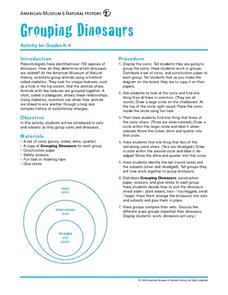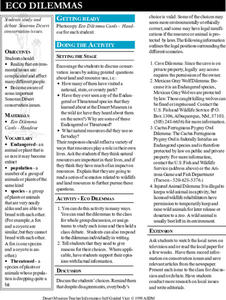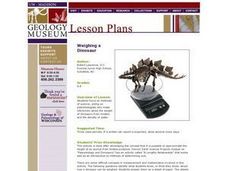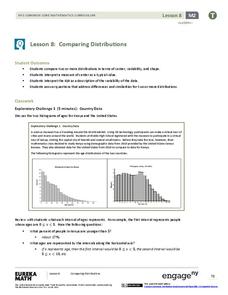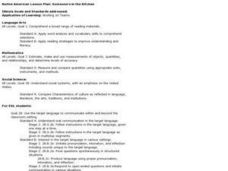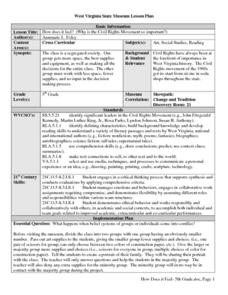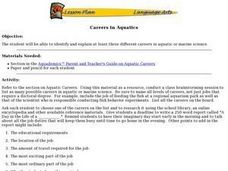Curated OER
Identify Navigational Instruments Instructions for Teachers
Students, who are teachers, learn about navigational instruments. They complete worksheets by searching for the names of the navigation tools using a websites.
Curated OER
Oregon Rainshadows
Students brainstorm list of possible highest locations in Oregon, identify and label places from list on map using color code, and discuss and identify causes of a rain shadow.
Curated OER
Mayonnaise Jar Greenhouse
Third graders examine the Greenhouse Effect, how it operates and finally allows the student to experiment using a model created in the classroom. They explain how the greenhouse effect affects the Earth.
Curated OER
Insect Communication and Harmful Insects
Seventh graders use children's literature in order to create an interesting context for the activity. The concept of insect communication is investigated in order for students to form educated hypothesis guesses.
Curated OER
What is a Fossil?
Students determine what a fossil is and distinguish between body fossils and trace fossils. They examine pictures of fossils and determine which represents a trace or body fossil.
Curated OER
Grouping Dinosaurs
Students investigate sets and subsets as they group coins and dinosaurs. Using scissors and provided sheet, they sort dinosaurs according to their commonalities. Their groupings are shared with the class.
Curated OER
Portland Observatory - Images
Students encounter the history and use of a Portland landmark. They explore history, communications, science, and museum visits. Students incorporate how to explore in the Maine Memory Network documents as well. An adventure for any...
Curated OER
Out of This World and Into Our Classroom
Students complete a background survey on technology to determine where they need to focus on to complete this project. Using the Internet, they research a topic in Astronomy they are interested in and determine what math concepts are...
Curated OER
Lend Me Your Ear
Students engage in a lesson to investigate some of the properties of sound. They create sounds and listen to the vibrations that are made while listing all the sounds that are heard. This is done while the eyes are closed to strengthen...
Curated OER
Insect Collection
Students investigate about various biological aspects of life, while examining desert insect species. They see the diverse range of species that live in the desert, despite the apparent lack of life in the desert. students tocomprehend...
Curated OER
Biology: Howler Monkeys Tell All
Students examine a PBS special about howler monkeys as an introduction to scientific forensic investigative methods. In groups, they conduct a host of experiments containing clues which point to discovery. By challenging assumptions,...
Curated OER
How to Make Copperas from Pyrites
Students produce copperas from iron pyrite nodules. In this chemistry instructional activity, students determine the different applications of copperas.
Curated OER
Sonoran Desert
Young scholars discuss the complicated environmental issues that face different people today. They establish legal positions surrounding several different scenarios.
Curated OER
What Does It Mean To Be a Good Citizen?
Young scholars study citizenship and what it means to be a good sitizen. They create their own country and determine its citizenship rules. They work together to create a visual representation of what makes a good citizen.
Curated OER
Drawing Plants with Plant Studio Freeware
Students identify parts of plants by name and the relationship among these parts as they use Plant Studio Freeware Wizard and tools on the computer to draw a particular plant from life or from a picture.
Curated OER
Weighing a Dinosaur
Learners role play as paleontologists who make inferences about the weight of dinosaurs. They use models and the density of water to make these inferences.
EngageNY
Comparing Distributions
Data distributions can be compared in terms of center, variability, and shape. Two exploratory challenges present data in two different displays to compare. The displays of histograms and box plots require different comparisons based...
Curated OER
What's Happening to the Ozone?
Learners identify causes of ozone depletion, generalize how that information affects everyday life, and discuss ways individuals can help slow down depletion of ozone.
Curated OER
Native American Lesson Plan: Someone's in the Kitchen
Students use vocabulary necessary to complete cooking activities and tell others about the food. They discuss similarities and differences between Native American and other nationalities' foods made in their families.
Curated OER
How does it feel? Why is the Civil Rights Movement so Important?
Fifth graders study the Civil War. In this US history lesson, 5th graders simulate what life was like during the Civil War by having two groups with one group given more materials than the other group. Students then draw a...
Curated OER
Wigwam
Learners create models of wigwams. They discuss winter and summer villages and the types of wigwams. They construct a wigwam using information from the Native American website to follow the scale. They present their models to the class...
Curated OER
Let's Go To Mexico
Students are able to use the Internet to conduct research. They research Mexican culture and traditions. Students compare and contrast Mexican and U.S. food and clothing. They convert United States currency to Mexican pesos. Students...
Curated OER
Extendable Bonko
Students create musical instruments to see how the length effects the pitch. For this Bonko activity, students use various size tubes to create a Bonko. Students experiment to observe the difference in the pitch.
Curated OER
Careers in Aquatics
Students discuss careers related to aquatic or marine science. They write a report called "A Day in the Life of a (blank)." After reports are completed, if possible a person working in the field of aquatic or marine science is invited to...





